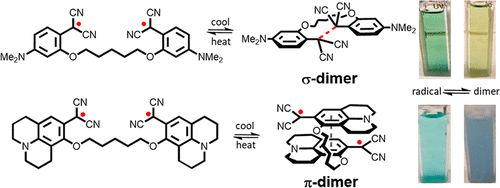当前位置:
X-MOL 学术
›
J. Am. Chem. Soc.
›
论文详情
Our official English website, www.x-mol.net, welcomes your
feedback! (Note: you will need to create a separate account there.)
Effect of Structure on the Spin-Spin Interactions of Tethered Dicyanomethyl Diradicals
Journal of the American Chemical Society ( IF 14.4 ) Pub Date : 2018-10-02 , DOI: 10.1021/jacs.8b08628 Rui Zhang 1 , Joshua P. Peterson 1 , Logan J. Fischer 1 , Arkady Ellern 1 , Arthur H. Winter 1
Journal of the American Chemical Society ( IF 14.4 ) Pub Date : 2018-10-02 , DOI: 10.1021/jacs.8b08628 Rui Zhang 1 , Joshua P. Peterson 1 , Logan J. Fischer 1 , Arkady Ellern 1 , Arthur H. Winter 1
Affiliation

|
Stable organic radicals with switchable spin states have attracted attention for a variety of applications, but a fundamental understanding of how radical structure effects the weak bonding interactions between organic radicals is limited. To evaluate the effect of chemical structure on the strength and nature of such spin interactions, a series of 14 tethered aryl dicyanomethyl diradicals were synthesized, and the structure and thermodynamic properties of the diradicals were investigated. These studies indicate that the nature of the dimer and the equilibrium thermodynamic parameters of the diradical-dimer equilibria are highly sensitive to the attachment point of the linker, the length of the linker, and the substituents on the radical itself. Values of the intramolecular Ka vary from as small as 5 to as high as 105 depending on these variables. An X-ray crystal structure for a linked ortho-substituted diradical shows that the diradical forms an intramolecular sigma dimer in the crystalline state with an elongated C-C bond (1.637 Å). Subtle changes to the radical structure influences the nature of the spin interactions, as fixing the dimethylamino substituent on the radical into a ring to make a julolidine-derived diradical leads to the weakest bonding interaction observed (Δ Gbonding = 1 kcal mol-1) and changes the spin-paired species from a sigma dimer to a diradical pimer. This work has implications for the design of stimuli-responsive materials that can reversibly switch between the dramatically different properties of closed-shell species and the unique properties of diradicals.
中文翻译:

结构对束缚二氰基甲基双自由基自旋-自旋相互作用的影响
具有可切换自旋态的稳定有机自由基已经引起了各种应用的关注,但对自由基结构如何影响有机自由基之间的弱键相互作用的基本理解是有限的。为了评估化学结构对这种自旋相互作用的强度和性质的影响,合成了一系列 14 个系链芳基二氰甲基双自由基,并研究了双自由基的结构和热力学性质。这些研究表明二聚体的性质和双自由基-二聚体平衡的平衡热力学参数对接头的连接点、接头的长度和基团本身的取代基高度敏感。取决于这些变量,分子内 Ka 的值从小到 5 到大到 105 不等。连接的邻位取代双自由基的 X 射线晶体结构显示,双自由基在结晶状态下形成分子内 sigma 二聚体,具有延长的 CC 键 (1.637 Å)。自由基结构的细微变化会影响自旋相互作用的性质,因为将自由基上的二甲氨基取代基固定成环以形成环戊二烯衍生的双自由基导致观察到的最弱的键合相互作用(Δ Gbonding = 1 kcal mol-1)和将自旋配对物种从 sigma 二聚体变为双自由基二聚体。这项工作对刺激响应材料的设计具有重要意义,这些材料可以在封闭壳物种的显着不同性质和双自由基的独特性质之间可逆地切换。
更新日期:2018-10-02
中文翻译:

结构对束缚二氰基甲基双自由基自旋-自旋相互作用的影响
具有可切换自旋态的稳定有机自由基已经引起了各种应用的关注,但对自由基结构如何影响有机自由基之间的弱键相互作用的基本理解是有限的。为了评估化学结构对这种自旋相互作用的强度和性质的影响,合成了一系列 14 个系链芳基二氰甲基双自由基,并研究了双自由基的结构和热力学性质。这些研究表明二聚体的性质和双自由基-二聚体平衡的平衡热力学参数对接头的连接点、接头的长度和基团本身的取代基高度敏感。取决于这些变量,分子内 Ka 的值从小到 5 到大到 105 不等。连接的邻位取代双自由基的 X 射线晶体结构显示,双自由基在结晶状态下形成分子内 sigma 二聚体,具有延长的 CC 键 (1.637 Å)。自由基结构的细微变化会影响自旋相互作用的性质,因为将自由基上的二甲氨基取代基固定成环以形成环戊二烯衍生的双自由基导致观察到的最弱的键合相互作用(Δ Gbonding = 1 kcal mol-1)和将自旋配对物种从 sigma 二聚体变为双自由基二聚体。这项工作对刺激响应材料的设计具有重要意义,这些材料可以在封闭壳物种的显着不同性质和双自由基的独特性质之间可逆地切换。











































 京公网安备 11010802027423号
京公网安备 11010802027423号